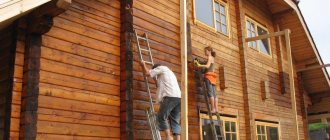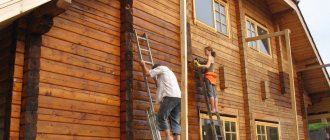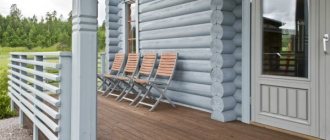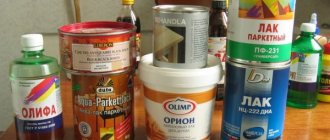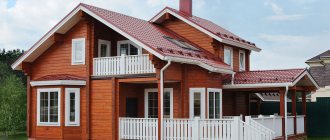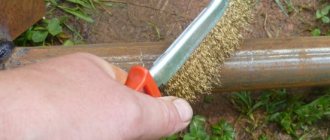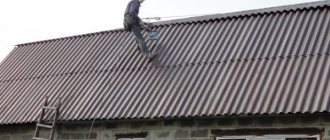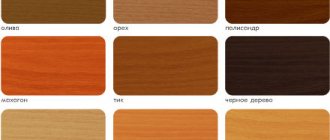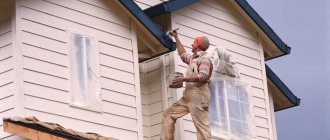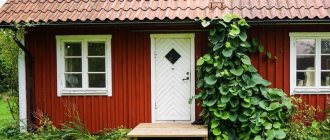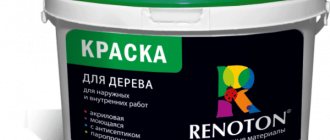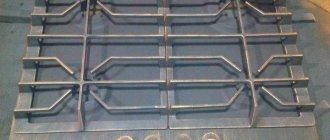- March 20, 2019
- Country house
- Marina Lobacheva
Wooden buildings are environmentally friendly, affordable and comfortable to live in. But wood is a rather complex material that is exposed to numerous atmospheric factors. It accumulates moisture, is destroyed by insects, and also often molds. Therefore, to protect a wooden structure, it is important to use some construction tricks to extend the life of the building. To do this, you need to use different paints or covering materials. Typically, building owners think about what kind of paint is best to paint the outside of a wooden house in order to improve its appearance and ensure its reliable protection. To do this, you can use different compositions that have their own unique characteristics.
Specifics of wooden buildings
Wooden houses are often chosen by many citizens to create a place for permanent residence. But it is important to remember some specific features of such houses. These include:
- the structure is lightweight, so it can be built on light and inexpensive bases;
- wood has the ability to allow air to pass through, so residential premises provide a favorable living environment for citizens;
- wooden houses have good thermal insulation parameters, so they do not require expensive insulation;
- before using such a structure, it is recommended to wait about two years until the shrinkage ends;
- since the material has good vapor permeability, it is important to use either ventilated facades or special coloring solutions for its finishing;
- It is additionally important to constantly use fire retardants, since wood is a flammable material;
- the tree is often damaged by insects and therefore needs specialized protection.
To protect the building from many negative factors, specialized facade paint is used. To do this, you need to choose compounds that are ideal for wood. They can be created on the basis of different components, so their parameters and costs can differ significantly.
How to choose paint?
Every owner of a wooden building should understand how to paint the outside of a wooden house. The service life, appearance and parameters of the house depend on this. When choosing the right composition, the following requirements for paint are taken into account:
- it must be specifically designed for facade work;
- it cannot contain any toxic or harmful components;
- No harmful compounds should be released into the air;
- the coating created must be resistant to various atmospheric influences;
- you should choose only paints that create a plastic coating, since it will be resistant to constant changes in temperature;
- the material must be wear-resistant.
To paint wooden walls, you can use innovative or traditional materials. They differ in composition, properties and cost. Therefore, each owner of such a structure must take a responsible approach to choosing durable wood paint for exterior use. The most commonly chosen compositions are oil, alkyd, acrylic or polyurethane.
Advantages and disadvantages
Different types of enamels, depending on the characteristics of their compositions, have both their advantages and certain disadvantages. For example, the advantages of oil paints include their good resistance to moisture. However, a significant disadvantage of such paints is the long drying period, which can range from 1 day to 48 hours. In addition, they have very low UV resistance, which is why they lose their shine and color saturation when exposed to direct sunlight.
Alkyd paints, on the contrary, have excellent resistance to various atmospheric factors. In addition, the advantages of these paints and varnishes include low cost and good resistance to low temperatures (up to -50 degrees Celsius). However, a significant disadvantage of alkyd paints is their high flammability. It is this feature that must be taken into account first of all when choosing this enamel.
In addition, they are extremely poorly resistant to the effects of various alkali compounds that may be contained in precipitation and, because of this, quickly lose their color. Therefore, when painting wood when performing outdoor activities, it is better to use white alkyd enamel. Acrylic products practically do not have any serious drawbacks. However, to paint 1m2 of material, you will need at least 200 grams of acrylic enamel.
Acrylic paint
If the owner of a building is thinking about how to paint the outside of a wooden house, then acrylic paint would be an excellent choice. The main parameters of this composition include:
- the created coating is characterized by excellent resistance to various atmospheric influences, such as temperature changes, strong winds, rain or snow;
- wood is protected from ultraviolet radiation;
- as a result of applying such paint, a special film is formed that has good elasticity, so even during the process of shrinkage of the house, cracks do not appear on the walls;
- the coating allows air to pass through well, which is important for a wooden residential building;
- the material dries quickly, but the duration of this process depends on the humidity and type of wood;
- a coating made from acrylic paint retains its color and characteristics for 8 years, and during this period of time you will not have to waste time and money on updating the film.
The disadvantages of acrylic paint include its high cost. The composition is available in different colors, so you can choose the most optimal solution for your existing residential building.
Oily
Oil paint for exterior woodwork is used by many owners of such structures. Its parameters include:
- the created coating is resistant to various atmospheric influences;
- the wood is protected from moisture;
- the paint has excellent penetrating ability, so the material is absorbed by the wood;
- If the painting procedure is carried out correctly, the result will be a glossy finish with a service life of at least 6 years.
The disadvantages of this solution include a long drying time, so it usually takes about a day. Painting wooden walls must be done in good weather.
Composition and technical characteristics
Enamel is a solution that consists of pigments or mixtures made on a varnish base. After the enamel has completely dried, an opaque matte film appears on the material being painted. There are many enamels for painting wood, which differ in both color and texture. In addition, it should be noted that the main advantage of enamels, for example, over oil-based products, is that they are much more elastic and have higher levels of hardness and strength.
Enamel substances are one of many types of paint and varnish products. Enamels for painting wood consist of several components. They are made using:
- varnishes;
- various special functional additives;
- fillers;
- solvents;
- pigments of certain color shades.
Enamels can be used to perform a wide variety of work. For example, they are often used during exterior or even interior work. It is worth noting that these paints can be used to paint not only wooden surfaces. They are also suitable for application to metal surfaces or even concrete walls and ceilings.
Important! Before applying enamel, the surface to be painted does not need to be pre-prepared. Work on painting wood should be carried out in a well-ventilated area and using personal protective equipment.
After coating with enamel, any material, be it wood or even metal, acquires increased resistance to adverse environmental influences. In addition, thanks to the use of these paints and varnishes, the painted surface of the wood becomes resistant to mechanical damage and the period of its wear and operation increases significantly.
Consumption per 1m?
The consumption of enamel when painting wood is influenced by several factors. For example, paint consumption depends on the tool used for painting, external conditions and the type of surface being painted. The average statistical norm when using enamels per 1 m2 of surface to be painted is about 130 grams.
However, the presence of related facts can either increase or decrease the cost of funds. In order to calculate this rate as correctly as possible for enamel when painting wood, it is necessary to take into account the parameters of its viscosity, as well as the condition of the outer layer of the material on which it is applied.
Important! As a rule, in windless, dry weather, enamel consumption per 1 m? decreases slightly when painting outside the room. However, when there is a strong wind or when outdoor work is carried out in intense heat, the enamel consumption indicators per 1 m? increase approximately 2 times.
Alkyd
It is quite difficult to say exactly which paint is best to paint the outside of a wooden house, since there are many different solutions that have their own positive parameters. Alkyd paint is considered a rather interesting choice. This composition is based on resin, so the main parameters of the paint include:
- the created coating is heat-resistant, so even when heated to 90 degrees, all the positive parameters of the material are preserved;
- alkyd paint is ideal for wood;
- the coating has a long service life.
It is necessary to apply the solution only to a surface that has been carefully prepared in advance, for which it is important to dry it well, otherwise the resulting coating will quickly begin to bubble and then swell. It takes about 12 hours for this composition to dry completely.
Water-based paint, its properties, in what cases it is used for wood
Repair work and construction are the main areas of application of water-dispersed compositions. The compound H2O, known to everyone from chemistry lessons, is the basis of water-soluble dyes, to which pigments and some other binding components are added. They are necessary for better adhesion (adhesion) to the surface being painted and obtaining an even protective layer.
The wood dries after processing. The molecules of the main component of the paint replace natural water molecules:
- when painting tree bark with water-based paint;
- in finished products when coloring the characteristic wood texture.
This treatment does not harm tree trunks, since it does not form an impenetrable polymer film, like other dyes.
Note! When painting fruit trees with water-based paint, lime is added to it. This is necessary to repel pests and rodents.
Knowing the composition, proportions and method of obtaining water dyes, you can make a similar mixture with your own hands for whitewashing garden trees - based on chalk, white clay, lime. In order to increase viscosity, modified additives and thickeners are introduced into the finished composition. Factory-made water emulsion for wood also fits well on the old lime mortar that was previously used to treat the fence and tree trunks.
When whitewashing a residential attic is required, water-based paint is often used to coat wooden beams and building materials joining them:
- foam concrete blocks;
- brickwork;
- plywood panels;
- plastered surfaces.
In interior design this is one of the most popular coatings. Decor specialists do not have a very large selection of “breathable” enamels that can absorb and release moisture.
Pay attention to: How to remove paint from linoleum
Latex
This type of facade paint appeared on the market relatively recently, but quickly became popular among owners of wooden houses. Features of the solution include:
- Latex-based paint is created, which guarantees its high ductility;
- the resulting coating easily allows air to pass through, so the main advantage of wooden buildings, which is their vapor permeability, does not disappear;
- the solution is not toxic, so you can create a coating without a respirator or other protective equipment;
- even if the paint is applied with a regular brush, an even and high-quality coating will be created.
The film obtained using latex paint can be cleaned even with the help of various detergents. This coating lasts on wooden walls for more than 10 years.
Rubber
This paint for painting the outside of a wooden house is similar in consistency to regular mastic. Composition characteristics include:
- the material is environmentally friendly, since no toxic or harmful components are used in the process of its creation;
- strength is due to the presence of acrylate latex;
- the coating is resistant to temperature changes;
- good adhesion to a wooden base is ensured;
- the material does not ignite, which is important for wooden buildings;
- the composition contains no toxic components.
If the coating is created in warm and dry weather, the material dries literally within two hours. The created film retains its performance parameters for 10 years.
What's included
The mixture is a combination of binding components and coloring pigments, which, when applied to wood, adhere well to the surface. The pigments are in the form of a suspension, so the paint is based on water. High-quality color distribution over the treated surface is achieved at the moment of volatilization of water molecules.
The following are used as an auxiliary component that enhances or improves the effect of the main composition:
- an antiseptic or antifungal agent that helps prevent the spread of mold;
- antifreeze to prevent paint from freezing;
- a thickener that allows you to maintain the required consistency of the composition;
- defoamer that prevents the formation of excess foam.
The composition that complies with GOST is marked VD on the packaging, which stands for water-dispersed.
What to choose?
It is simply impossible to say exactly which of the above solutions is the best paint for painting the outside of a wooden house. This is due to the fact that each composition has both advantages and some disadvantages.
To preserve the original appearance of the house, you can use not paints, but various impregnations, varnishes, stains or waxes. Each solution has its own purpose, but it is important to use fire retardants and antiseptics. These compounds are intended to protect wooden surfaces from fire and insects.
The most popular compositions
There are several options for painting the outside of a wooden house. A specific method is selected only after suitable paint has been purchased. What paint is best to paint the outside of a wooden house? It is most preferable to buy the following types of compounds:
- Finnish paint "Tikkurila", which can be alkyd-urethane or polyurethane-acrylate. It contains antiseptics and does not contain harmful components. The coating lasts more than 10 years, and you can also choose the composition of a suitable color from 120 options. The paint dries in 4 hours, and the cost of 1 liter is approximately 800 rubles.
- “Belinka” is represented by Slovenian facade paint, which protects wooden walls from fungus, insects and mold. If you properly apply the composition to the base, the coating will last more than 15 years. On average, the cost of 1 liter ranges from 600 to 900 rubles.
- "Drevoplast" is a company that creates various antiseptic products designed to effectively protect wood from numerous negative influences. Impregnation can be used not only outside, but also directly in residential premises.
- Teknos paints have a high cost, which is due to the long service life of the coating. If the paint is applied taking into account numerous requirements, the film will last about 30 years. Typically, this composition is chosen to cover houses built from expensive wood.
There are many other types of paints on the market. They have different parameters, prices and shades. What paint is best to paint the outside of a wooden house? You can choose any option, so the buyer must focus on his preferences, financial capabilities and characteristics of the composition.
Rating of the best wood paints for exterior use
The best manufacturers of paints and varnishes for outdoor use are well-known brands.
Although some prefer to make the composition themselves:
If you want to buy ready-made, then this information is for you:
"Belinka" is a company that has been producing paint and varnish materials for more than 30 years. It occupies a leading position in the global market for the production of facade products;
Alpina is the most experienced paint and varnish company in existence for over 100 years. It produces paint and varnish materials for exterior and interior use. Its products are universal. "Alpina" produces compounds to create a protective layer not only on wood, but also on metal and other surfaces;
"Olsta" is a company that creates first-class wear-resistant materials. They do not contain harmful impurities, they are safe;
Premium products of the Dulux brand retain their protective properties in any weather and in any climatic conditions;
"Neomid" (more than 30 years of experience) produces odorless paints.
Preparing the walls
As soon as you choose how to paint the outside of a new wooden house, it is important to prepare the walls of the building for the upcoming procedure. Preparation is required for new and old buildings. To do this, perform the following steps:
- Initially, dirt or dust is removed from the walls, for which you can simply wipe the walls with a dry cloth or rinse the base well;
- if there are traces of mold, then the necessary areas of the surface are treated with special compounds that destroy spores;
- if tree resin is detected, it is removed, after which the damaged areas are covered with varnish;
- If there are nails or other metal fasteners in the walls, they must be coated with a special primer designed for working with metal surfaces.
Next, you need to dry the walls well, for which the structure must stand in the sun for at least two weeks. Therefore, it is best to carry out the staining procedure in the warm part of the day.
How to properly paint the outside of a wooden house?
The coloring procedure is not considered too complicated or time-consuming, so anyone can handle it, regardless of any specific experience. To do this, after preparation, the following steps are implemented:
- the walls are covered with a primer, and you need to choose compounds that contain antiseptics and fire retardants;
- after the primer has dried, the preparation of the coloring composition begins;
- It is important to stir the paint regularly while working;
- The material can be applied with a spray gun or brush;
- to obtain a uniform, high-quality, colorful and rich shade, it is recommended to use color;
- It is not allowed to work in the sun, so it is best to carry out the process in the evening;
- dyeing is carried out in warm and dry weather;
- compositions are applied along wood fibers;
- It is advisable to form several layers at once, with each layer applied only after the previous layer has completely dried.
Before using any composition, it is important to make sure that the solution is not expired, otherwise a poor-quality and short-lived coating will be obtained.
“I will show you paints and stains and even some varnishes...”
Good afternoon Natasha Udovina and the team of the TAIR Creative Studio are with you. I want to tell and show how you can paint wood in different ways. Paint in a broad sense. I will show you paints and stains and even some varnishes. All the techniques that I showed can be combined with each other and select any colors.
All these methods are applicable on small objects, such as a box, and on furniture. For the next master class, I was planning to decorate such a chest of drawers.
1. Full painting with paint For any type of painting without highlighting the texture of the wood, it is necessary to thoroughly prepare the surface for work. I specifically chose a piece of wood that had a crack in the knot and obvious unevenness. To make the surface smooth, it is necessary to seal the cracks. I use gesso primer; regular putty will also work.
Using a spatula, the composition is rubbed into the depths of the unevenness, and the excess is removed. note
that the aqueous composition may sag a little in deep cracks after drying and re-puttying will be required. After drying, I sand the gesso primer until it is perfectly smooth.
Next, to save paint consumption and facilitate its application, you need to cover the absorbent surface of the wood and gesso with primer, inexpensive paint or varnish. I apply white acrylic primer diluted with water. Next, paint of the selected color is applied with a wide flat brush.
As much as you might want to finish this process quickly, remember that it is better to apply several thin coats to dry rather than one thick coat. This will help avoid obvious brush marks and make the coloring even. In this method, I hide the wood texture as much as possible, but if you want to preserve it, then you need to do without putty and primer.
What mistakes are made?
If the owner of the building prefers to independently engage in work related to covering wooden walls with protective compounds, then he should know how to paint the outside of a wooden house. The design needs to be thought out in advance to achieve an attractive finish. But at the same time, citizens often make the following mistakes:
- not much attention is paid to the preliminary preparation of the wood base;
- For old houses, sanding of walls is not used;
- the correct paint application technology is violated;
- the temperature regime is not maintained during operation;
- paint is applied to damp wood;
- materials that are not suitable for wood are selected.
Such errors lead to the fact that the created coating does not protect the base and does not last too long. Therefore, before performing work, it is important to study the rules for its implementation.
